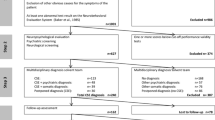Abstract
It is well known that exposure to manganese, solvents, or carbon monoxide in an occupational setting may lead to central nervous system damage and parkinsonism. The most important solvents in this respect are methanol, toluene, carbon disulfide, and n-hexane. We describe three patients who had been exposed to various solvents for more than 20 years (25, 34, and 46 years). They presented with parkinsonism, pyramidal signs, mild cognitive decline, and unresponsiveness to levodopa. Two patients had a predominantly axonal and sensory polyneuropathy of the lower legs with fasciculations in one of them. Parkinsonian features were progressive, even after the patients had stopped work. We present clinical data, neuropsychological findings, and results of brain computed tomography or magnetic resonance imaging, electroneuromyography, evoked potentials, single photon emission computed tomography, and positron-emission tomography. There is growing evidence that various organic solvents give rise to a parkinsonism syndrome with pyramidal features in susceptible individuals.
Similar content being viewed by others
Author information
Authors and Affiliations
Additional information
Received: 22 December 1997 Receibed in revised form: 17 July 1998 Accepted 21 July 1998
Rights and permissions
About this article
Cite this article
Hageman, G., van der Hoek, J., van Hout, M. et al. Parkinsonism, pyramidal signs, polyneuropathy, and cognitive decline after long-term occupational solvent exposure. J Neurol 246, 198–206 (1999). https://doi.org/10.1007/s004150050334
Issue Date:
DOI: https://doi.org/10.1007/s004150050334




